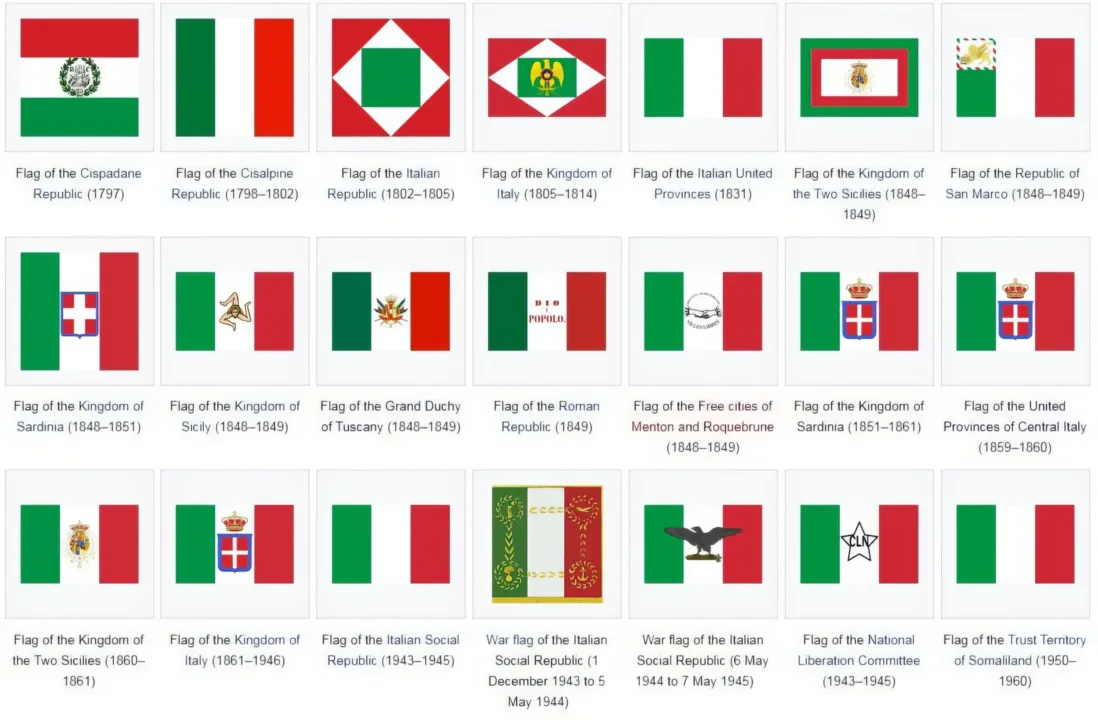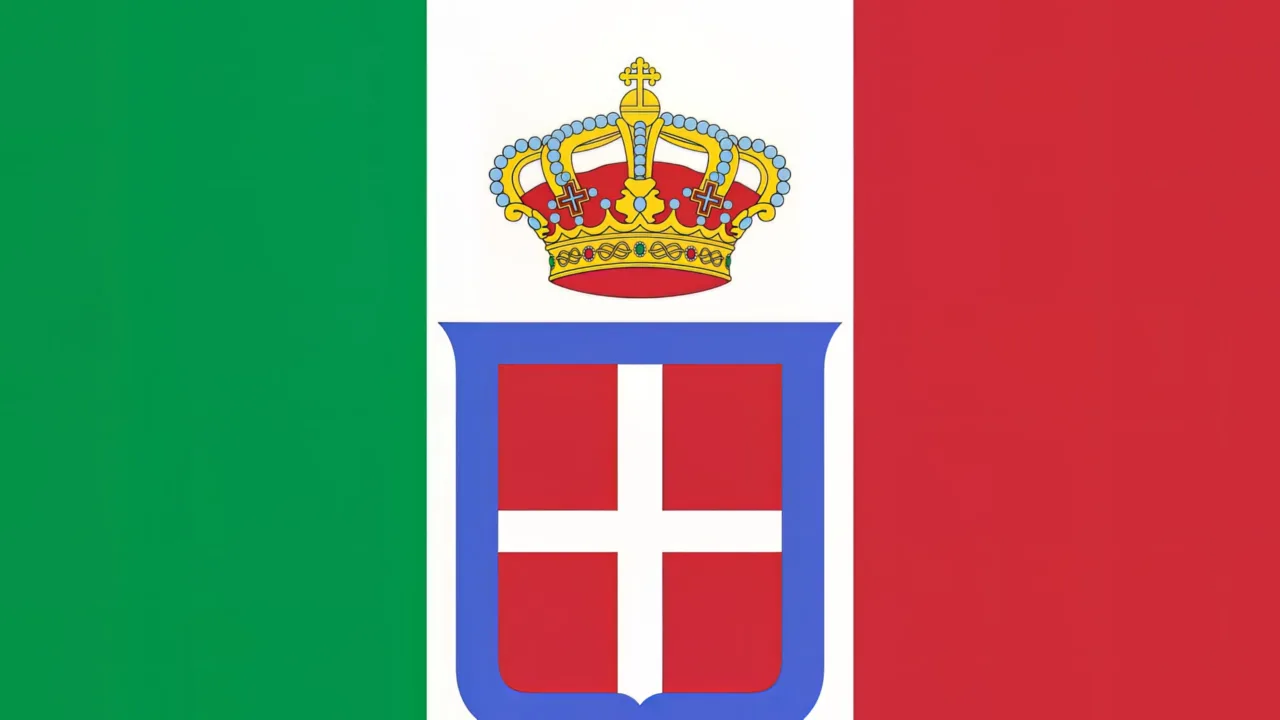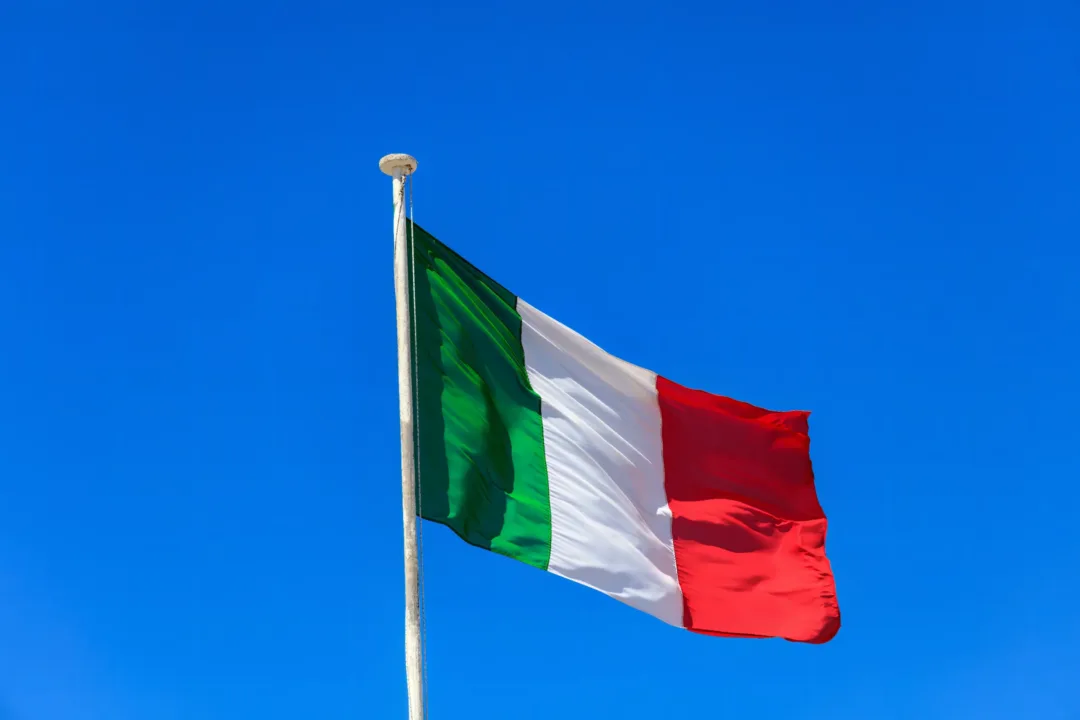The Italian flag, or “Il Tricolore” in Italian, is a tricolor flag that consists of three equal vertical bands of green, white, and red. Each color holds symbolic significance and represents various aspects of Italian history, culture, and values.
The Italian flag is one of the most recognizable and iconic symbols of Italy. It is composed of three vertical stripes; that are colored green, white, and red, respectively, from left to right. The green stripe symbolizes the country’s lush landscapes; while the white represents peace, purity, and the snow-capped peaks of the Alps. The red stripe symbolizes the blood shed by Italian patriots; who fight for the country’s freedom and unity. The colors are placed in equal proportions, and they are arranged in a sequence that is simple yet powerful.

The Italian states would become a confederation, styled after the earlier Roman and Holy Roman Empires. The head of state was to become a new Italian Emperor, crowned by the Pope. But lacking one, the Pope would become the de facto head of the confederation.

The origin of the Italian flag; can be traced back to the struggles for independence and unification that took place in the 19th century.
During this time, many regions of Italy were ruled by foreign powers, and the nation was divided into various independent states. The idea of a unified Italy gained popularity among the people, and the tricolor flag became a symbol of this movement. The Italian patriot, Giuseppe Garibaldi, says to carry a tricolor flag during his military campaigns. Further, it was adopted as the official flag of Italy in 1946, shortly after the end of World War II.

Obviously, the design of the Italian flag has remained unchanged for over a century. Again, it continues to be a source of pride and identity for the Italian people. The flag is often displayed during national celebrations, sporting events, and other important occasions. It is raised high on flagpoles, draped over buildings, and waved by enthusiastic crowds.
Italian flag colors have significant meanings. It goes beyond their symbolic representation of nature and patriotism. The green stripe reflects hope, growth, and fertility. The white stripe embodies harmony, safety, and honesty. The red stripe represents love, courage, and sacrifice. The colors are not only visually appealing. But they also convey a message of unity and belonging that resonates with Italians around the world.

The Italian flag has inspired many other countries to adopt similar designs, including Mexico, Ireland, and Hungary.
It is a testament to the enduring power of a simple yet iconic symbol that can unite a nation and inspire patriotism for generations. The flag is a reminder of Italy’s rich history, diverse culture, and unwavering spirit.
Starting from the left side, the first band of the Italian flag is green. Green is a symbol of hope, fertility, and the country’s lush landscapes. It represents the fertile plains, rolling hills, and verdant countryside that are characteristic of Italy. The color green also represents the country’s strong agricultural tradition and connection to nature. This symbolizes the importance of the land and the beauty of Italy’s natural resources.
Whereas, the middle band of the Italian flag is white. White represents peace, purity, and the aspiration for unity. It symbolizes the desire for harmony among the diverse regions and people of Italy. The color white also signifies the values of truth, honesty, and integrity that are cherished in Italian society. It reflects the country’s commitment to diplomacy. Also, its pursuit of peaceful coexistence with other nations.
Thereafter, the third and final band of the Italian flag is red.
Red symbolizes courage, strength, and the spirit of sacrifice. It represents the bloodshed and sacrifices made by Italians; throughout their history in the pursuit of independence, freedom, and national unity. The color red also embodies the passion, vitality, and energy that are inherent in Italian culture. It signifies the determination and resilience of the Italian people in the face of challenges and adversity.
The current design of the Italian flag was officially adopted on June 18, 1946, following the fall of Fascism and the end of World War II. However, the tricolor scheme dates back to the late 18th century. And has undergone several variations throughout Italian history.
Besides, the origins of the tricolor flag can be traced back to the French Revolution. The ideals of liberty, equality, and fraternity that spread across Europe during that time. The design was inspired by the French flag, which also consists of three vertical bands of blue, white, and red. The Italian flag’s colors were chosen to reflect the unique values and characteristics of the Italian people.
The significance of the Italian flag extends beyond its visual representation.
Indeed, it serves as a powerful national symbol that unites Italians and instills a sense of pride and identity. The flag is prominently displayed during; national holidays, sporting events, and official ceremonies, serving as a reminder of Italy’s history, culture, and shared values.
The Italian flag is a reflection of the country’s rich heritage, diverse landscapes, and vibrant culture. Flag embodies the principles of hope, peace, unity, courage, and strength that are deeply rooted in Italian society. It is a testament to the enduring spirit and resilience of the Italian people throughout history.
Formerly, the flag is also a popular design choice for clothing, memorabilia, and crafts. There is a wide range of items featuring the Italian tricolor; from hats and t-shirts to tote bags and keyrings. The design is an attractive; vibrant way to show one’s love of Italy and appreciation for its culture. And then, flag is often used by businesses who wish to transmit a sense of Italian pride to customers.
Exactly, the Italian Flag is a beloved symbol that evokes a strong sense of national pride and history. Through its red, white, and green colors, it speaks to the values of the Italian people. In addition, its presence brings unity and strength to all who behold it.
Whether fluttering in the breeze atop public buildings; adorning sports stadiums, or proudly displayed by citizens during national celebrations. The tricolor flag of Italy represents the essence of the nation. It encapsulates the beauty, passion; and indomitable spirit; that have shaped Italy and continue to inspire generations of Italians both at home and abroad.
Reference -> Wiki

